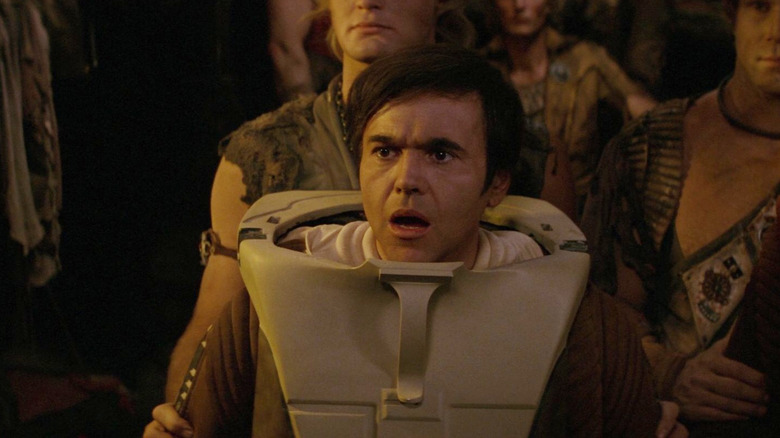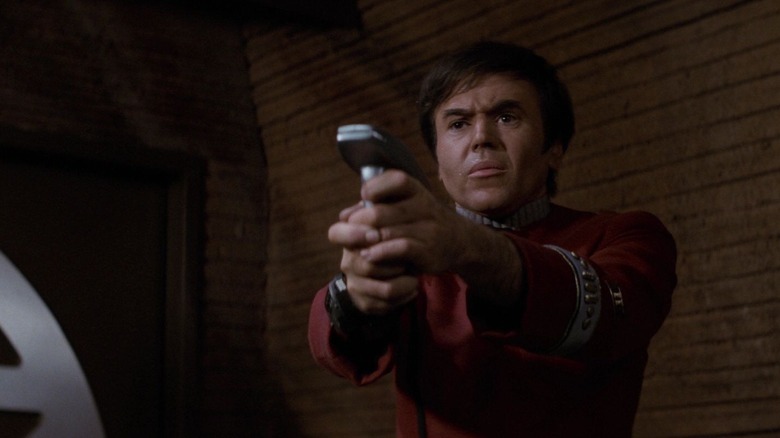Walter Koenig's Simple Suggestion Probably Saved The Star Trek II Script
"Star Trek II: The Wrath of Khan" went through many, many iterations. Trekkies may be able to tell you about several early drafts. Producer Harve Bennett, for instance, completed his first "Star Trek II" treatment in November 1980, and it told the story of Captain Kirk (William Shatner) traveling to a distant planet to quell a political rebellion. When he arrives, he discovers that the rebel leader is his son, whom he hadn't previously known about. Kirk and his son then team up to fight the planet's tyrant: Khan (Ricardo Montalbán). A later treatment, written by screenwriter Jack Sowards and titled "Star Trek II: The Omega Syndrome," involved, as the title implies, a doomsday device developed by the Federation.
Bennett began synthesizing these two ideas and eventually came up with a story involving Khan, Kirk's son, and a doomsday device, but altered to be more positive and helpful. Specifically, the doomsday device became the Genesis device, a terraforming widget that can make dead planets habitable.
In those early drafts, Bennett and Sowards both had Leonard Nimoy's stalwart Vulcan Spock being killed at the end of the first act. Spock was the most popular "Star Trek" character, and killing him, they felt, would be a shock comparable to Marion Crane's death in "Psycho." As we all now know, of course, Spock does indeed die in "Star Trek II," but at the end of the film. It's long been rumored that Spock's death was altered after an early "Star Trek II" script draft leaked, and Trekkies strenuously objected. It seems, though, that Bennett and Sowards also got feedback from a higher authority.
Speaking to Stuff in 2017, Pavel Chekov actor Walter Koenig revealed that he, too, suggested moving Spock's death to the end of "Star Trek II," where it would be more dramatic. Whether it was the angry Trekkies or Koenig himself, the screenwriters listened.
Walter Koenig suggested moving Spock's death to the end of the movie
According to Koenig, a producer handed him an early "Star Trek II" script draft to test if it would pass muster with Trekkies. Koenig was only a Terkkie insofar as he was part of the main ensemble, but he knew enough about the franchise to know what a good "Star Trek" script would require. Koenig knew that every "Star Trek" story needed three things to succeed. As he put it:
"Spock's death was an extraordinary turn of events for 'Star Trek.' The producer asked me to do a 'Trekkie run' on the script, and I told him that he cannot kill Spock in the first act, which was the way the first draft was drawn. There are three elements in 'Star Trek' that are absolutely synonymous with what it's about, and they have to be maintained or, if they are lost, it has to be an extremely theatrical and dramatic way. That's Kirk, Spock, and the Enterprise. You cannot dismiss one of those elements as a first-act problem and then go on to the rest of the story."
Koenig noted that, by moving Spock's death to the end of "Star Trek II," the film's story became more effective and functioned better as a drama. The movie's writers "did a wonderful thing" in listening to him and other Trekkies, Koenig noted. There's an element of sacrifice to Spock's death as well, giving more heft to the film's battle-heavy climax. Koenig added that the climactic ending imbues the movie's narrative with a better sense of "empathy" and a "sense of humanness that was extremely important to the story's success."
And Koenig is 100% correct. While killing Spock a third of the way into the film would have been dramatic, it's simply a better story to have him die at the end.

